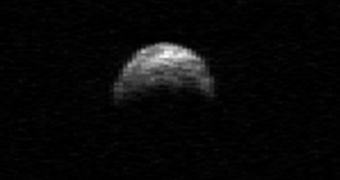Experts using the largest single-aperture telescope in the world have recently imaged a new near-Earth object (NEO) passing close to our planet. Designated as 2005 YU55, the space rock was observed on April 19 using the Arecibo Observatory in Puerto Rico. The facility, with its 305-meter (1,001-foot) aperture, is capable of producing tremendously-detailed images in radio wavelengths, and is uniquely qualified to conduct high-quality NEO research. The facility is operated by astronomers at the Cornell University, in Ithaca, New York, under a cooperative agreement with the US National Science Foundation (NSF).
Following the new observations session, the orbit and path of 2005 YU55 was significantly refined. The new datasets were then sent to the Near-Earth Object Program Office, which centralizes information from numerous such studies. The facility is managed by experts at the NASA Jet Propulsion Laboratory (JPL) in Pasadena, California. Following a thorough analysis of the recent observations, scientists determined that the chances of this particular asteroid impacting our planet within the next century are fairly remote.
Because it operates in radio wavelengths, the massive telescope cannot produce visible-light images of its targets. This image was obtained by analyzing the radio echo the rock produced upon being targeted. JPL scientists say that the object was located some 2.3 million kilometers (1.5 million miles) away from Earth at the time of the study. For this reason, the National Astronomy and Ionosphere Center (NAIC) – the alternate name for the Arecibo Observatory – only managed to produce photos with a resolution of 7.5 meters (25 feet) per pixel. But the data were sufficiently precise to allow astronomers to determine that the diameter of the asteroid is about 400 meters (1,300 feet).
“At one time we had classified 2005 YU55 as a potential threat. Prior to the Arecibo radar passes on April 19 thru [sic] 21, we had eliminated almost all upcoming Earth flybys as possibilities of impact. But there were a few that had a low remaining probability of impact. After incorporating the data from Arecibo, we were able to rule impacts out entirely for the next 100 years,” explains JPL NEO Program Office scientist Steve Chesley. JPL manages these tracking efforts for the NASA Science Mission Directorate, in Washington DC.

 14 DAY TRIAL //
14 DAY TRIAL //